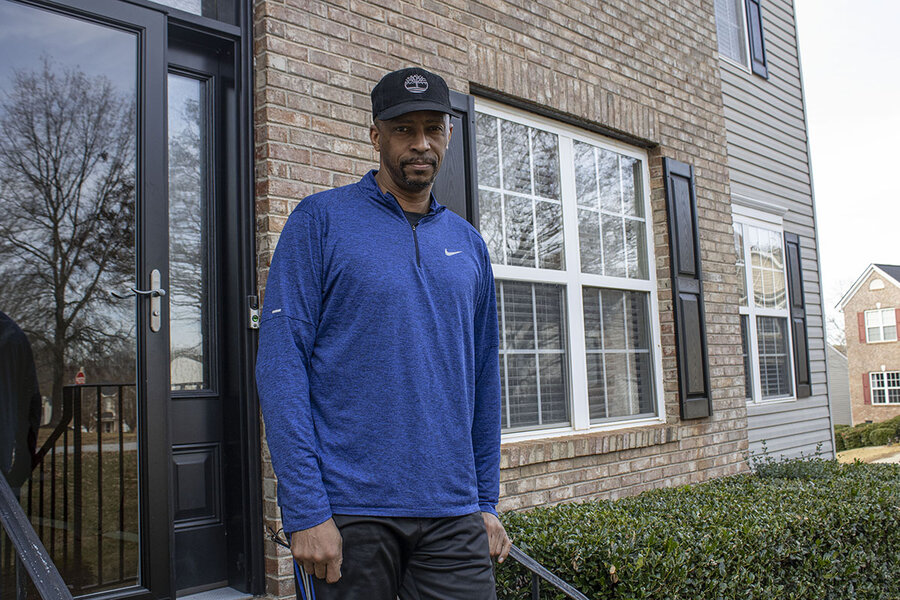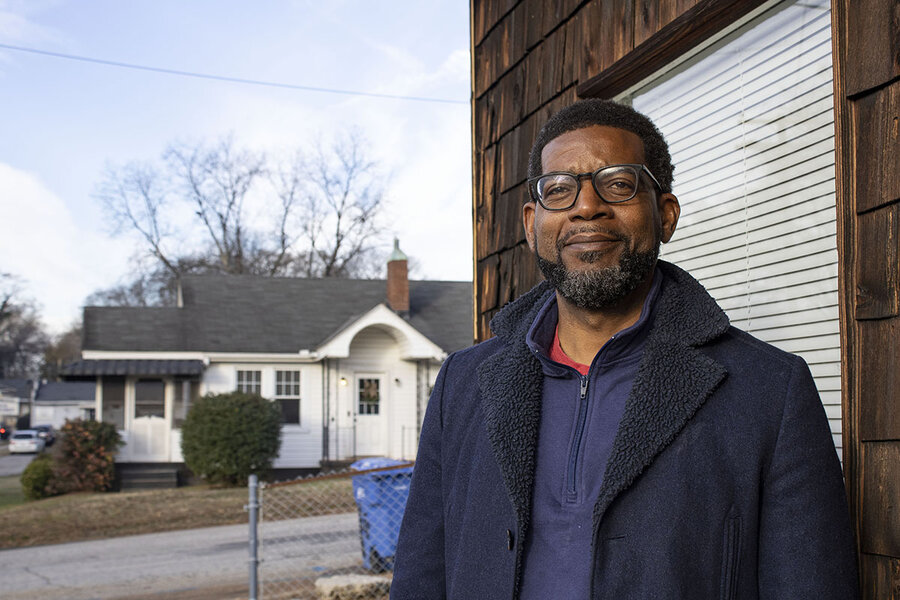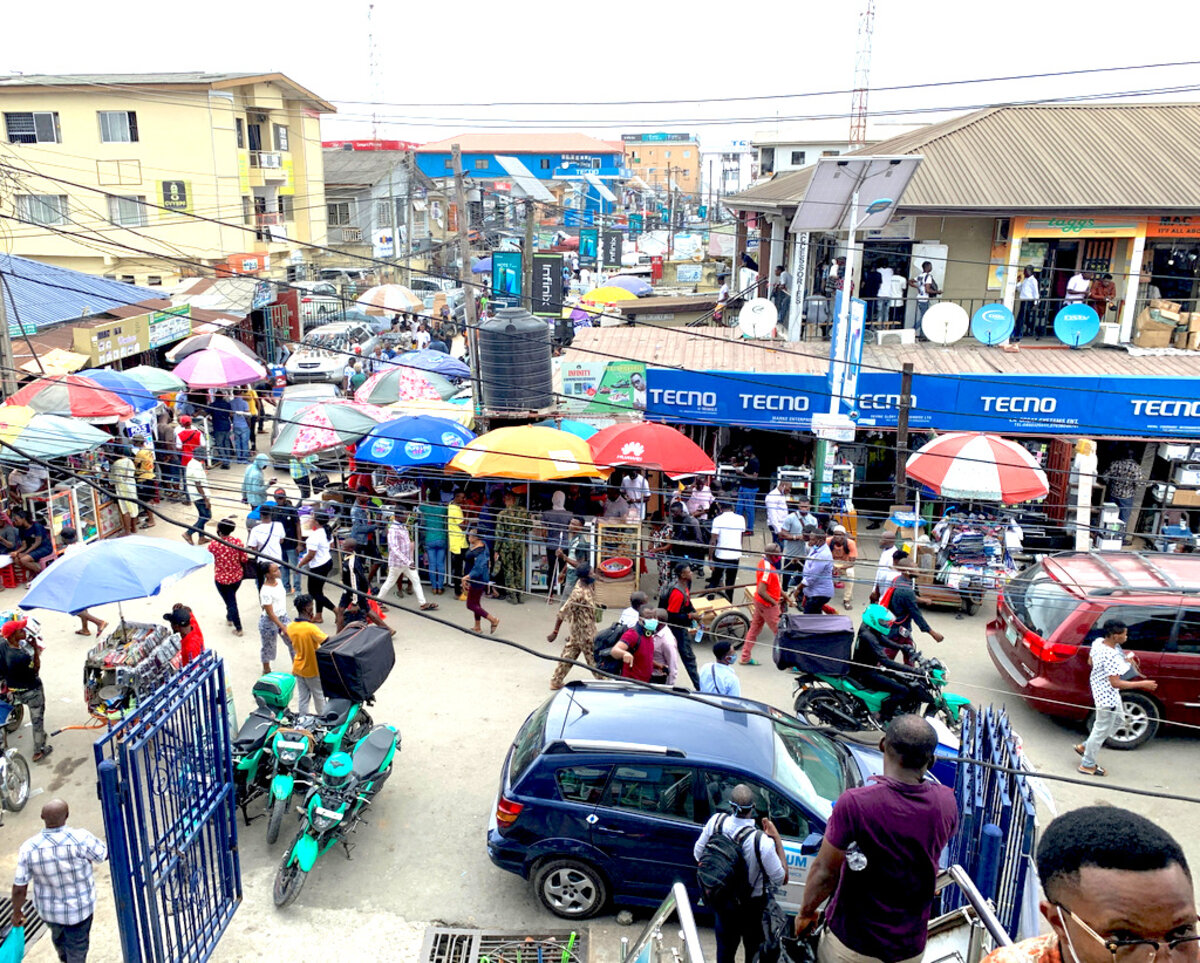- Quick Read
- Deep Read ( 8 Min. )
Monitor Daily Podcast
- Follow us:
- Apple Podcasts
- Spotify
- RSS Feed
- Download
TODAY’S INTRO
Matters of perspective
Today we’re highlighting shifts in perspective that could influence how two major stories play out in 2024. The first concerns Black U.S. voters, a bedrock of Democratic support. In South Carolina, political reporter Story Hinckley explains why noticeable cracks are emerging in that coalition – and interest in Donald Trump is ticking up.
Pivot to Israel, where the military announced further reductions in troops in Gaza. Outside pressure is surely a factor, but there’s another concern: navigating a war that is likely to grind on. As correspondent Neri Zilber points out, that means calibrating what the nation of nearly 10 million people can handle not only militarily, but also economically and socially.
Share this article
Link copied.

Help fund Monitor journalism for $11/ month
Already a subscriber? Login

Monitor journalism changes lives because we open that too-small box that most people think they live in. We believe news can and should expand a sense of identity and possibility beyond narrow conventional expectations.
Our work isn't possible without your support.
Biden’s urgent task: Reengaging Black voters
Black voters, like many Americans, show only tepid support for President Joe Biden. But for the Democratic Party, the concern runs deeper: What if a segment of voters it has long counted on is growing less attached to the party overall?

President Joe Biden went to South Carolina on Monday to give his second major campaign speech of the new year, highlighting what he sees as the high stakes of the upcoming presidential election. He was also trying to shore up support among Black voters, a key Democratic constituency that has seemed less enthusiastic about his candidacy of late.
Although 92% of Black voters supported Mr. Biden in 2020, one recent poll found fewer than two-thirds saying they will back him this November.
Many Democrats have concerns about Mr. Biden’s age, and his candidacy has been weighed down by the impact of inflation and various foreign conflagrations. The greater worry for Democrats, however, is that the problem reflects a growing disenchantment among Black voters with the party itself, fueled by a sense that years of partisan loyalty haven’t resulted in tangibly better outcomes.
“In 2020, during the middle of a pandemic and the George Floyd protests, there was this feeling that all we had to do was show up and vote for Joe Biden,” says Joel Payne, a Democratic strategist. “And in some parts of the Black voter coalition, they think they are not getting what was promised.”
Biden’s urgent task: Reengaging Black voters
It’s no exaggeration to say that Black voters put President Joe Biden in the White House.
After disappointing fourth- and fifth-place finishes in Iowa and New Hampshire, Mr. Biden’s 2020 presidential bid was nearly moribund. But then a blowout win in South Carolina – where a majority of Democratic primary voters are Black – put him on a fast track to his party’s nomination. Nine months later, he won the general election against former President Donald Trump with 92% of the Black vote. Elected alongside him was the United States’ first Black vice president, Kamala Harris.
“I stand here today as your president because of you,” Mr. Biden said Monday, speaking at the historic Mother Emanuel AME Church in Charleston, where a white supremacist killed nine people in 2015. “And I’ve done my best to honor your trust.”
Lately, however, the relationship has been showing some cracks. In a November GenForward survey, fewer than two-thirds of Black voters said they planned to support Mr. Biden in this year’s presidential election, with 20% saying they planned to vote for someone other than him or former President Trump. That followed an October New York Times poll of battleground states that showed Mr. Trump garnering 22% of the Black vote, a massive leap from the 8% he won three years ago – and, if those numbers wind up being even somewhat accurate, a potential political earthquake for Democrats.
Several factors may be driving this apparent shift. Polls show that many Democrats have concerns about Mr. Biden’s age and ability to serve another term. His candidacy has also been weighed down by the impact of inflation and various foreign conflagrations. The greater worry for Democrats, however, is that the problem may not be specific to Mr. Biden. It may reflect a growing disenchantment among Black voters with the party itself, fueled by a sense that years of partisan loyalty haven’t resulted in tangibly better outcomes.

“[For] Black voters who showed up in 2020, during the middle of a pandemic and the George Floyd protests, there was this feeling that all we had to do was show up and vote for Joe Biden,” says Joel Payne, a Democratic strategist and former director of Hillary Clinton’s African American paid media in 2016. “You have all of these implied promises that people thought they were getting when they voted against Trump and for the Democrat. And in some parts of the Black voter coalition, they think they are not getting what was promised.”
Covering Campaign 2024
What goes into writing about a handful of candidates’ monthslong presidential runs? Working tactically to gain the up-close access that brings insights into not only the nuances of the behavior and messaging, but also the public response. That’s the heart of the story. Guest host Gail Chaddock, a veteran of the game, chats with a Monitor rising star, politics writer Story Hinckley, just ahead of primary season 2024.
The president’s trip to South Carolina on Monday was his second major campaign speech of the new year, as he attempts to highlight what he sees as the high stakes of the upcoming presidential election. But it also underscored the political challenge he faces. Mr. Biden’s speech was interrupted at one point by protesters calling for a cease-fire in Gaza – an issue that has sharply divided the Democratic coalition.
A lack of excitement
Of course, Mr. Biden still retains the vast share of Black voters’ support. And 10 months out from Election Day, it’s hard for polling to accurately simulate the “forced choice” that voters will actually face, says Mr. Payne. In a Biden-Trump rematch, the Democratic strategist contends, there is “no realistic scenario” in which Mr. Trump would ever win 22% of Black voters.
Still, in a campaign expected to be tight, even a slight shift toward the GOP – or a decision by some Black voters to simply stay home – would matter. In 2016, Mrs. Clinton lost Michigan and Wisconsin, and subsequently the presidency, because turnout among Black voters there wasn’t high enough to counter Mr. Trump’s surging support among the white working class.
That challenge would be compounded if Mr. Trump’s working-class support were now to include more voters of color. Indeed, as education polarization continues to accelerate, one result may be political parties that are less racially polarized, with more college-educated white voters backing Democrats, and Black voters who don’t hold college degrees increasingly finding themselves at home in the GOP.
In Greenville, South Carolina’s most-populated county, residents complain about the rising cost of everything from groceries to housing. Mr. Biden comes across as uninspiring and old, say workers at Mario’s Auto Detailing across the street from the city of Greenville’s Unity Park, but that’s not the most frustrating part. It just doesn’t feel like he’s made things any better, says one man shining a sedan’s rims who voted for Mr. Biden in 2020 but doesn’t plan to vote this year.
“Is there a lot of excitement this time around to vote for Biden? The answer is no,” says Pastor Curtis Johnson of Greenville’s Valley Brook Outreach Baptist Church.

He predicts many of his parishioners will vote for Mr. Biden in 2024 if the election is a Biden-Trump rematch, but he says that doesn’t mean there aren’t serious frustrations with the Democratic Party. He lists some of the main concerns: “We need to create a living wage with the out-of-control cost-of-living expenses. Housing. The out-of-control immigration system is impacting a lot of the inner cities. It still feels like the Voting Rights Act isn’t permanent.
“It’s important that we hold whoever gets our vote accountable and articulate the concerns that are still there,” he adds.
Frustration in Greenville
Last fall, this growing frustration with the Democratic Party led Mr. Johnson to try a new tack. He and five other Black pastors from the Greenville area penned a letter endorsing a Republican candidate for City Council over the Democratic incumbent.
“Those of us who have lived through the 1950s, ’60s, ’70s and ’80s recall a time when we had a potent, trustworthy and loyal ally in the Democratic Party and much was accomplished then, but things are different now,” they wrote. “Our young people, who do not see us gaining new ground and even losing the ground we had gained, see no true value in blind loyalty. ... They have recognized a truth that we should not ignore: That our community gains nothing from being a reliable tool of one political party.”
The letter caused an immediate stir, admits Mr. Johnson, and it soon took on “a life of its own.” National media outlets called, asking the men if they planned to vote for former President Trump. He tried to explain that they weren’t repudiating all Democrats, just a local incumbent (who went on to win reelection). But he understands why it generated such an intense reaction.
“The letter spoke to a more national concern,” says Mr. Johnson. “There are some frustrations across the country with the Democratic platform.”
To combat this, local Democratic parties need to “step up” and educate voters about what the Biden administration has accomplished, says Stacey Mars, chair of the Greenville County Democratic Black Caucus. They need to remind older Black adults that the Biden administration capped the cost of insulin for seniors on Medicare at $35, and remind young Black voters about the administration’s efforts to block junk fees on sites like Ticketmaster.

“It’s the messaging,” agrees Kwadjo Campbell, a teacher and Democratic operative in Greenville. “People are wondering, ‘What has Biden done for me?’ Well, spend the money to tell them.” Last month, Mr. Campbell was ousted from his position as the state executive committeeman for the Greenville Democratic Party after he served as a media contact for the Greenville pastors who endorsed the Republican. He says the party should take the entire episode as a wake-up call.
“Biden is just an easy scapegoat,” he says. “Locally, statewide, and nationally, Democrats have a Black voter problem.”
Still, Mr. Biden has a history of pulling off improbable wins, note other Democrats. Just look at South Carolina in 2020, when his come-from-behind win made the seemingly impossible happen.
This year Mr. Biden has tapped South Carolina as the site for the Democrats’ first primary contest, in a bid to give nonwhite voters a greater say in the nominating process.
Black voters will ultimately “come home” to Mr. Biden when faced with the choice between him and Mr. Trump or a third-party candidate, predicts Celinda Lake, a Democratic pollster who worked for the Biden campaign in 2020. The Biden campaign is employing the same Black voter turnout efforts, through social media and door-knocking, that it used in 2020, she says. But she acknowledges that she is “concerned” by the polling.
“We need African American voters to be very enthusiastic and solidified,” says Ms. Lake.

Today’s news briefs
• Hezbollah commander killed: A senior commander of the militant group Hezbollah was killed by an Israel airstrike in Lebanon, a Lebanese security official says.
• Avoiding a government shutdown: Congressional leaders reached an agreement on overall spending levels for the current fiscal year. The deal could help avoid a partial U.S. government shutdown later this month.
• Boeing 737 Max aircraft grounded: U.S. federal authorities have grounded some Boeing 737 Max aircraft after an Alaska Airlines jetliner was forced to land Jan. 5. An exit door that was “plugged” because it was not being used blew off in flight.

War in Gaza tests Israel’s stamina
War brings clear costs: lives lost or forever changed, homes destroyed. As Israel girds for a long war in Gaza, and tensions rise in Lebanon, it is trying to balance, too, the human and economic costs of mass mobilization.

- Quick Read
- Deep Read ( 6 Min. )
-
By Neri Zilber Contributor
As the campaign against Hamas grinds on in Gaza, Israel is digging in for a long war – militarily, economically, and socially. It’s an effort both to achieve its ambitious objectives and to make the battle sustainable for its citizenry.
“The year 2024 will be challenging,” Israel’s military chief, Lt. Gen. Herzi Halevi, said Sunday. “We will be fighting in Gaza all year, that’s for sure.”
On the ground in Gaza, the Israeli military has shifted to a “lower-intensity” phase of its offensive, at least in the northern part of the territory, reducing the need for the same level of massed army divisions – and reservists.
Ori Barzilay, who works for a Tel Aviv tech investment firm, just recently returned home after three months in uniform, though it was made clear to him to be ready to meet the army’s needs for the entirety of the coming year.
His wedding plans, meanwhile, are on hold: The uncertainty of the current moment is the only certainty. His fiancée, a medical student, who was also called up, has yet to be demobilized.
“We were looking at this coming spring ... but it’s an open question whether it’ll be possible,” Mr. Barzilay says. “It’s the first time our generation has experienced a war of this magnitude.”
War in Gaza tests Israel’s stamina

Ori Barzilay was planning his wedding when Hamas launched its devastating Oct. 7 attack on Israel.
Like more than 300,000 other Israeli civilians, he immediately left his regular life and went off to war, in his case as a reservist in an elite intelligence unit.
After nearly three straight months in uniform, he only recently returned home, part of a wider demobilization – for now – of Israeli forces.
As the campaign against Hamas grinds on in Gaza, and the threat of a wider escalation with the Iran-backed Hezbollah grows in Lebanon, Israel is digging in for a long war – militarily, economically, and socially. It’s an effort both to achieve its ambitious objectives and to make the battle sustainable for its citizenry.
“The year 2024 will be challenging,” Israel’s military chief, Lt. Gen. Herzi Halevi, said Sunday. “We will be fighting in Gaza all year, that’s for sure, and this will also hold [for] the other arenas.”
Mr. Barzilay, a principal at Team8, a Tel Aviv-based tech investment firm, was told by his commanders not to get too comfortable back in civilian life.
“We were kind of released,” he says, adding that it was made clear to him to be ready to meet the army’s needs for the entirety of the coming year.
“There will be peaks up and down. It’s not [a binary] 0 or 1; it’s a dynamic situation,” he adds.
“Lower-intensity” phase
Now over three months into the war in Gaza, much of Israel has returned to a semblance of (wartime) normalcy.
Rocket barrages from the battered Palestinian enclave onto Israeli cities have nearly stopped, with more incoming alerts tallied in northern Israel in recent weeks due to intensifying Hezbollah fire. At the stroke of midnight on New Year’s Eve, revelers in Tel Aviv barely heard the last major Hamas volley – and those that did continued with the festivities until the small hours of the night.
On the ground inside the Gaza Strip, the Israeli military has shifted to a “lower-intensity” phase of its offensive, at least in the northern part of the territory, deploying less firepower and more targeted raids against Hamas targets. While heavy fighting has continued in Gaza’s center and south, the need for the same level of massed Israeli army divisions – and reservists – has decreased.
Yet Israeli military officers maintain that much work remains to be done: Half of Hamas’ 24 battalions are still functioning, the group’s leadership is still alive, and there are still more than 100 Israelis being held hostage inside Gaza.

In tandem, tensions are also growing with Hezbollah, with the powerful Shiite movement exchanging fire daily with Israeli forces.
Last week, a senior Hamas leader, Saleh al-Arouri, was killed in a suspected Israeli missile strike in Beirut. Hezbollah vowed to retaliate, and this past weekend fired on a critical Israeli military installation as part of what it termed an “initial response.” On Monday Hezbollah said a senior commander, Wissam Hassan Tawil, had been killed in an Israeli airstrike.
More than 80,000 Israelis have been displaced from their homes on Israel’s northern border, heaping pressure on the government of Prime Minister Benjamin Netanyahu to find a solution to the Hezbollah threat – whether via ongoing United States-backed diplomatic efforts or through military force.
“The probability of [outright] conflict in the north is greater than 50%,” said Gabi Ashkenazi, a former Israeli military chief and foreign minister, at a recent economics conference at Herzliya’s Reichman University. “So we have to assume that we’ll need to deploy force.”
Facing such an array of uncertainties over an extended period of time, Israel now intends to make the situation more workable, especially on the home front.
“The reserve array will be built in such a way that they can go out to freshen up, the Israeli economy can function, [and] families waiting for their loved ones can get back to routine,” Rear Adm. Daniel Hagari, the chief military spokesperson, said last week. “The fighting will be long, there are many challenges, and we must do this. ... We will still need the reservist forces” in the future.
Yearning for normality
At the economics conference where Lieutenant General Ashkenazi spoke, university students milled about, their semester only just beginning in late December. Those young reservists who had already been released were recognizable for the assault rifles slung over their shoulders, alongside their backpacks.
Inside the lecture hall, finance officials and academics attending the conference put on by the Aaron Institute for Economic Policy were of one mind: The Israeli economy in the coming year was looking at slower growth (and likely a recession), with higher budget deficits due to the massive cost of the war, including increased defense spending to levels not seen in decades.
“Oct. 7 was a transformative date for Israel. ... Our defense doctrine collapsed,” said Maj. Gen. Amos Yadlin, a former military intelligence chief, on a recent call with journalists.
“[Now] what is needed is a different defense doctrine, with different initiatives. The [prior] addiction to tranquility is gone,” he said in remarks directed at Hamas, Hezbollah, and other external Israeli enemies. “Those who don’t understand that will feel the fire.”

Yet tranquility and normality and routine are exactly what Israelis, and especially those on the home front, yearn for – even in wartime. The toll on reservists, and their families, has been immense.
Ben, a reserve officer in a combat brigade headquarters who asked that his full name not be used, was mobilized and deployed last month to the Gaza front. Unlike others in his unit, he tries to make it back home every night, even if just for a few hours, to see his 1-year-old son and wife.
“It’s been very difficult on her; she’s exhausted,” Ben says. “There are a lot of babysitters and family help ... and we have it easier than most.” His wife was recently told she’s being laid off, an economic blow that other reservists, especially those who are self-employed, are well acquainted with.
Yet despite it all, Ben adds, “no one is eager to end this before we finish the job” against Hamas. “Time is working in our favor. Every day we’re there [inside Gaza], we’re dismantling them.”
The certainty of uncertainty
This shared sense of mission, even months into one of Israel’s longest wars, is still evident – despite the high cost and, oftentimes, dissonance of the current moment.
After returning home, the 29-year-old Mr. Barzilay found the “routine” of go-go Tel Aviv, with its bars and cafes full again, “very odd and strange” after the reality of military life and the scenes of devastation in Gaza.
“But later I realized it’s a wonderful thing to see, and also important for the economy, which is no less an important front in this war. This is why I do reserve duty, to protect it all,” he says.
As for his upcoming wedding, those plans are still on hold: The uncertainty of the current moment is the only certainty.
His fiancée, a medical student, was also called up for reserve duty. Unlike him, she has yet to be demobilized.
“We were looking at this coming spring, and we still want to do it then. But it’s an open question whether it’ll be possible,” he says. “It’s the first time our generation has experienced a war of this magnitude.”

How gerrymandering changes US politics: One district’s story
The 1st Congressional District in South Carolina was trending blue. Now it’s deep red. In the change is the story of modern American politics.

- Quick Read
- Deep Read ( 5 Min. )
Six years ago, South Carolina’s 1st Congressional District elected a Democrat for the first time in 30 years. Newcomers drawn to the state’s low taxes and light regulation were slowly bending the state’s politics leftward.
Then state Republicans redrew the political map. Republican Nancy Mace won the next election, though narrowly. Now, she’s winning comfortably, and her rhetoric has changed. She became an outspoken player in the battle over the House speakership, at one point donning a “Scarlet Letter”-type “A” on her shirt. She has also floated herself as a possible vice presidential candidate for former President Donald Trump.
Democrats gerrymander, too. One analysis suggests that neither party is gaining a significant numerical advantage. But polarized districts not only elect redder and bluer representatives, but also accelerate a sense of estrangement.
“The 1st District is really a great microcosm of the American story in this moment,” says one election expert. “If we’re just thinking about the baseline rule of what is ... technically legal, then we’re missing out on what makes our democracy function.”
How gerrymandering changes US politics: One district’s story

South Carolina’s 1st Congressional District essentially traded Lester Aiken for Steve English.
In redrawing the state political map in 2020, Republicans pushed out Mr. Aiken, who is Black and leans liberal, and brought in Mr. English, who is white and leans conservative.
To talk to the two voters about it, the switch might not seem like such a big a deal. Mr. Aiken’s isn’t bothered by the charge that his neighborhood was moved because it is predominantly Black. “I don’t look at the world in Black and white,” he says.
Mr. English, who lives in rural Berkeley County, agrees. “I get it. We’re country, and they’re the city; we’re conservative, and they’re liberal,” the third-generation fishing guide says. “But we probably have more in common than we don’t.”
Yet the new political map has brought a revolution. A district that was trending left has now veered starkly right. And beyond Charleston, a state that was seeing new shoots of Democratic support is now represented by Republicans in six of seven districts.
“Too poor to paint, too proud to whitewash,” a Charleston saying used to go. Now the GOP has effectively painted one of the South’s most liberal corners red. A lawsuit challenging the legitimacy of the redrawn district has made it to the United States Supreme Court.
There is no question the state remains deeply conservative. And it is also clear that Democrats engage in gerrymandering, too. An Associated Press study found that neither side has gained a decisive numerical advantage. “Republicans won just one more U.S. House seat in 2022 than would have been expected based on the average share of the vote they received nationwide,” the report found.
But how does the nation’s polarized politics emerge from voters as seemingly affable and reasonable as Messrs. Aiken and English? The 1st District shows not only how polarized districts elect redder and bluer representatives, but also how they accelerate a sense of estrangement.

Aggressive partisan redistricting “starts to disconnect people from their ... representation,” says Doug Spencer, an election scholar at the University of Colorado Law School in Boulder. Those people, in turn, “start to look at political bodies and realize that it’s not a reflection of the underlying population.”
Supreme Court scrutiny
The 1st District legal case is one of a dozen court challenges across the Sun Belt, where a rising share of the nation’s population is gravitating. It alleges that lawmakers illegally “bleached” the 1st District of 30,000 Black voters, most of whom, like Mr. Aiken, lean Democratic. A panel of three federal judges ruled that the new electoral map could only be interpreted as “stark racial gerrymander,” which, unlike partisan gerrymandering, is illegal.
At an October hearing, several U.S. Supreme Court justices seemed skeptical about the legal merits of that argument. But focusing only on the legality of the move misses the deeper point, says Professor Spencer.
“The 1st District is really a great microcosm of the American story in this moment,” he says. “If we’re just thinking about the baseline rule of what is ... technically legal, then we’re missing out on what makes our democracy function. Is there a commitment to winning elections through ideas and mobilization? Or is it that we’re going to change and embed structures in a way that keeps us in power? Those are two different sets of values, and you can’t write those values into law.”
The results in the 1st District have been striking.
Six years ago, the 1st Congressional District elected a Democrat for the first time in 30 years. Newcomers drawn to the state’s low taxes and light regulation had been ironically bending the state’s politics gradually leftward.
After redistricting, Republican Nancy Mace won, though narrowly. Now, she’s winning comfortably, and her rhetoric has changed. She became an outspoken player in the battle over the House speakership, at one point donning a “Scarlet Letter”-type “A” on her shirt. She has also floated herself as a possible vice presidential candidate for former President Donald Trump, despite clashes with him.
“Back when Nancy Mace had won by a razor-thin margin over a Democrat, she had to pay a lot more attention ... to both Democrats and Republicans in the district,” says DuBose Kapeluck, a political scientist at The Citadel in Charleston. Now “her job has become a lot easier, and she can vote the reliably Republican way.”

In Bennett’s Point, a remote fishing village south of Charleston, 1st District resident Nathan Hollinger says voters are being used as pawns.
“Politicians are trying to segregate us by ideology, party, race, and ethnicity, for their own benefit,” he says. “The focus is on the circus in Washington, and that’s how they like it.”
Not as red as it seems?
Even now, the 1st District has more texture than the maps might suggest. Representative Mace has cast herself as a maverick. (She was the first woman to graduate from The Citadel, Charleston’s famed military college.) She has championed women’s rights, marijuana legalization, and a ban on offshore drilling.
New 1st District voter Mr. English also says there’s more to him than “anybody but Biden.” Even as a fiscal conservative, he says lawmakers need to address the impacts of growth on communities. “There should be a more significant impact fees on developers so that new development helps fund better schools and roads,” he says.
Yet the new 1st District epitomizes a United States where residents are self-segregating – and being mapped – into ideological chunks. America is no longer a melting pot. It’s more of a “lumpy salad bowl,” says James Gimpel, a political scientists at the University of Maryland.
In Charleston, Mr. Aiken is aware of these trends. He says he knows the new voting maps are meant to secure political power at the risk of driving Americans further apart. But he has hope the spirit of the city can overcome partisan instincts.
“The most important thing to me is what I see around me, which is a city on the rise,” he says. “This is about coming together as communities and voters to do what’s best for where we live.”

Community restores Compton bakery after street ‘takeover’
Rioting, looting, and protests that turn violent often create challenges for a community. This city responded to one such test in a swift and positive way.

- Quick Read
- Deep Read ( 5 Min. )
In the early hours of Tuesday, Jan. 2, a raucous “street takeover” by vehicles and onlookers outside of a Compton, California, bakery devolved from racing stunts like doughnut-spinning into looting. One car slammed into the security grate of Ruben’s Bakery and Mexican Food, Inc., breaking through the entrance. A mob ransacked the place, stealing goods worth more than $70,000.
The bakery and meat store, founded 48 years ago by Ruben Ramirez Sr. as a taco stand, is a fixture in this community. The business survived the 1992 LA riots and the COVID-19 pandemic. Would an illegal street takeover – a disruptive and sometimes fatal phenomenon – do it in?
Family, friends, and employees pitched in to clean up and repair “a shambles,” as Ruben Ramirez Jr. describes it. The local council member’s office donated paint.
Against all expectations, the bakery reopened three days later as proof of the power of community, and a testament to recovery after tragedy.
Now regulars and strangers were lining up at the counter. Rosa Aldaz, emerging from the bakery with bread and champurrado, a chocolate drink, has a message for looters. “Stop and think,” she urges. “Would you want that for your family?”
Community restores Compton bakery after street ‘takeover’
Ruben Ramirez Jr. hoped 2024 would start with a bang for his struggling, family-owned bakery in Compton, just south of Los Angeles. But he wasn’t thinking of a destructive bang like this – or the unexpected generosity it would spark.
In the early morning hours of Tuesday, Jan. 2, a raucous “street takeover” by vehicles and onlookers at the intersection outside of the bakery devolved from racing stunts like doughnut-spinning into looting. A Kia Soul reversed forcefully into the security grate of Ruben’s Bakery and Mexican Food, Inc., breaching the entrance. A mob of about 100 people then trashed the place, and made off with cash, equipment, and food – an estimated loss of more than $70,000.
Three Kings Day, a Christian celebration, was coming up on Saturday. It’s a big business opportunity for a Mexican bakery, and the Ramirez family was looking forward to a boost from orders of roscas, the circular-shaped sweetbread for the occasion.
The bakery and meat store is a fixture in the community, founded 48 years ago by the senior Ramirez as a taco stand. The business had survived the LA riots of 1992, and the recent COVID-19 pandemic – though barely. Would an illegal street takeover – a disruptive and sometimes fatal phenomenon that plagues some California cities – do it in?
Against all expectations, the bakery reopened for business on Friday morning, just three days later, as proof of the power of community and a testament to rebirth and recovery after tragedy. “We didn’t think we would be ready,” said a grateful Mr. Ramirez, standing outside the honey-colored store that morning.
At 10:00 a.m., business looked brisk. Workers shaped rosca dough in the back room, handed breakfast burritos to eager customers for takeout, and rolled out stacked trays of bolillos, a short baguette. Family, friends, and employees had pitched in to clean up and repair “a shambles,” as Mr. Ramirez Jr. describes it. The local council member’s office donated paint. Now regulars and strangers were lining up at the counter, and TV news crews that showed up to chronicle the unfolding story of community unity were reporting from the store.

When Mr. Ramirez Jr. arrived at the scene of broken glass and destruction in the wee hours of Tuesday, he felt deeply angry. Then sad. Now he is overcome by the tremendous outpouring of goodwill since news got out about the looting. A woman from Texas had even called on Friday morning to pray with him – something he’s been doing a lot. “I’m overwhelmed by the response,” he says, especially for his dad, Ruben Ramirez Sr. “The more that people call, the bigger the smile on his face.”
The desire to help was instant. A friend from high school, Luis Arandia, texted Mr. Ramirez Jr. and offered to set up a GoFundMe page. He didn’t know how to do it, but he knew someone in the strategy business, Ulisses Sanchez, who did. Before long, the page was up, and the media had been contacted. As of Monday, 1,700 people had contributed more than $85,000 – which was $10,000 over the original goal. “It took one phone call,” says Mr. Arandia, who tears up in the telling.
Several customers drove from a distance to support the bakery on its first day back in business. It took Jimmy Torres, who came with his mother and two daughters, 45 minutes to drive from his home in Long Beach. Like other customers that morning, he had learned about the looting on the news. The family left the bakery clutching their bags of bolillos and sugary churros. “Totally worth it,” says Mr. Torres. His mother adds that Latinos are “trying to help each other.”

The bakery has deep roots in the low-income neighborhood of small single-family homes and garden apartments, many of them with security doors. Juanita Cervantes has been a customer for decades, and even though she moved a couple towns away seven years ago, she still comes two-to-three times a week for the bread and authentic food. The bakery is “very good for the community,” she says. “This is our place,” agrees another customer, Robert, who declined to give his last name.
Mr. Ramirez Jr. is grateful that law enforcement officers got there quickly Tuesday. However, vehicles were dispersing and looters were leaving by the time sheriff deputies arrived, and “they weren’t able to detain anyone or make any arrests,” says acting captain, Lt. Melissa Ramirez, at the Compton station of the Los Angeles County Sheriff’s Department. Still, “the community has been great” with calling in tips, she says. “We have received quite a few leads.”
Street takeovers, also called sideshows, occur in urban areas throughout the state, from Oakland to Bakersfield to San Diego. They’ve been a part of car culture, especially in Southern California, for years, but took off during the pandemic when wide boulevards were largely empty. They can involve anywhere from 100 to 300-plus vehicles, blocking intersections and streets and are organized over social media, says Lieutenant Ramirez. Crowds gather to watch revved-up vehicles burn rubber and hurtle around intersections.

Citizens complain of the danger, noise, and tire-burn smell. More recently, takeovers have involved property damage and burglaries, says Lieutenant Ramirez.
The Compton area saw 114 street takeovers between April and the end of November last year, and law enforcement issued 400 citations, made 148 arrests, and impounded 109 vehicles, according to Lieutenant Ramirez. In 2002, two women were killed at a Compton street takeover. The LA County Sheriff’s Department is trying to regain control through a special task force with other law enforcement agencies, “bot dots” installed in an X-form at intersections, and $1,000 citations for onlookers.
Rosa Aldaz, emerging from the bakery with a bag of bread and champurrado, a beloved chocolate drink, knows street takeovers all too well. She works late at night, and has encountered several on her way home. She has a message for those who looted the bakery. “Stop and think,” she urges. “Would you want that for your family?”

In Pictures
Namibia and the elephant I’ll never forget
Regular Monitor readers know that photographer Melanie Stetson Freeman is routinely smitten by animals. But on safari in Namibia’s Etosha National Park, it is her reporting partner who is left awestruck.

- Quick Read
- Deep Read ( 2 Min. )
-
Sara Miller Llana Staff writer
A childhood dream of mine was to see an elephant – probably because of Ellie, the stuffed elephant I was given on my first birthday that still lives with me.
My tour of Etosha National Park in Namibia with photographer Melanie Stetson Freeman was coming to an end when I finally spotted one trudging solitarily across a barren field. I asked our guide if we could wait just a few minutes.
The guide cut the engine as the enormous beast approached and 15 minutes later paused right in front of us, seeming to give us a look before majestically walking on.
Quietly, I stared in awe. I could have sat there watching it all day, but it was time to go.
Expand this story to view the full photo essay.
Namibia and the elephant I’ll never forget
On every reporting trip, staff photographer Melanie Stetson Freeman stops to convene with animals – whether they’re stray cats and dogs in Turkey or guanacos in the Chilean Patagonia. I can appreciate these creatures, but her love and enthusiasm for them always outmatches my own. Often I have to coax her away.
This held true as we observed giraffes, zebras, oryxes, and springbok while on assignment at Etosha National Park in Namibia. That is, until we spotted the elephant. Solitarily, it trudged across a barren field in the distance en route to one of the many watering holes that draw an abundance of wildlife during the winter’s dry season in this park, one of Africa’s largest.
A childhood dream of mine was to see an elephant – probably because of Ellie, the stuffed elephant I was given on my first birthday that still lives with me. Our tour was coming to an end, but I asked our guide if we could wait just a few minutes to see what the elephant would do.
The guide cut the engine as the enormous beast approached and 15 minutes later paused right in front of us, seeming to give us a look before majestically walking on.
Quietly, I stared in awe. I could have sat there watching it all day, but it was time to go. Otherwise it would have been Melanie hurrying me along.





Other headline stories we’re watching
(Get live updates throughout the day.)The Monitor's View
Africa’s deep think in being an AI leader
- Quick Read
- Deep Read ( 2 Min. )
-
By the Monitor's Editorial Board
Previous generations of young African leaders sought to lift their people first through anti-colonial revolution and later through regional pacts on trade and security. The goal was always the same: prosperity and dignity through unity and self-governance.
Many of today’s African youth seek similar goals but by embracing the opportunities in artificial intelligence. They face obstacles such as slow internet and electricity shortages. Yet young innovators are determined to apply advances in machine learning to Africa’s economic growth. They aim to show that the continent can be more than a recipient of imported ideas. “We need to show up in our relationship with the West as equals,” said Avishkar Bhoopchand, a South African research engineer who works at Google DeepMind in London.
Several countries are already applying AI in a range of contexts. Nigeria and Ghana use it to boost election transparency. Rwanda has positioned itself as a hub for innovation policy and ethical use of AI. In Sudan, the technology has enabled the first nationwide mapping of schools, including in conflict areas.
With AI, Africa’s youthful innovators are generating a new view of their region and themselves as equal contributors to global progress.
Africa’s deep think in being an AI leader

Previous generations of young African leaders sought to lift their people first through anti-colonial revolution and later through regional pacts on trade and security. The goal was always the same: prosperity and dignity through unity and self-governance.
Many of today’s African youth seek similar goals but by embracing the opportunities in artificial intelligence. They face obstacles such as slow internet and electricity shortages. Yet young innovators are determined to apply advances in machine learning to Africa’s economic growth. They aim to show that the continent can be more than a recipient of imported ideas.
“We need to show up in our relationship with the West as equals,” said Avishkar Bhoopchand, a South African research engineer who works at Google DeepMind in London, in an interview with Inside Higher Ed. “Not one in which the West sees us as a charity case – or, worse, as a testing ground for their technology or one in which they can exploit or extract resources from Africa.”
Several countries are already applying AI in a range of contexts. Nigeria and Ghana use it to boost election transparency. Rwanda has positioned itself as a hub for innovation policy and ethical use of AI. In Sudan, the technology has enabled the first nationwide mapping of schools, including in conflict areas.
The application of AI has stirred a buzz stretching the capacity of universities from Cairo to Cape Town. Students, professors, and entrepreneurs are creating a network to support one another. One particular concern is developing local data sets to ensure deep-think programs are loaded with African knowledge and languages.
“More and more, young people launching startups are interested in this, and they have a real thirst for knowledge in the field of AI,” Seydina Ndiaye, a member of the new United Nations AI Advisory Body from Senegal, told UN News last week. “With the development of AI, we could use this channel so that Africa’s cultural identities are better known and better valued.”
There are already more than 2,400 AI organizations in Africa spanning a range of contexts, from health care and agriculture to education and government statistics. The International Data Corporation estimates that global digital investment in Africa will double from 2023 levels in three years. The Bill and Melinda Gates Foundation announced last October it would invest $30 million to support “home-grown” AI innovators.
Such digital transformation “offers an opportunity for a new form of economic growth for developing countries, with the added possibility of countries being able to ‘leap’ stages of development – and in so doing to support structural change that provides employment opportunities and rising standards of living,” the Brookings Institution stated in a report last year.
The creative embrace of machine learning in Africa is reminiscent of the early days of Silicon Valley, when the first gadgets of the information age emerged from the garages of determined young inventors. With AI, Africa’s youthful innovators are generating a new view of their region and themselves as equal contributors to global progress.

A Christian Science Perspective
Each weekday, the Monitor includes one clearly labeled religious article offering spiritual insight on contemporary issues, including the news. The publication – in its various forms – is produced for anyone who cares about the progress of the human endeavor around the world and seeks news reported with compassion, intelligence, and an essentially constructive lens. For many, that caring has religious roots. For many, it does not. The Monitor has always embraced both audiences. The Monitor is owned by a church – The First Church of Christ, Scientist, in Boston – whose founder was concerned with both the state of the world and the quality of available news.
Facing what we fear
- Quick Read
- Read or Listen ( 4 Min. )
-
By Larissa Snorek
We can rely on Christ to inspire in us the strength and confidence to accomplish what’s necessary and good, even when something seems daunting.
Facing what we fear
Have you ever noticed how the things we may least want to face turn out to be the exact things that help us grow the most?
Even with the best intentions, we can sometimes find ourselves attempting to use prayer to avoid something difficult. And yet, scientifically approached prayer as described in Christian Science brings things to the surface to be dealt with and resolved. It gives us the courage to face down whatever might seem impossibly hard to deal with, so we can move forward.
This prayer holds us to a high standard. It is much more than just wishing or hoping that something will change – or, that something which needs to change will stay the same. Prayer that yields our thinking to the divine power brings a shift in thought, transforming us and equipping us to face challenges with an absolute confidence in the all-power of good from God – infinite Spirit, Love.
Christian Science identifies this transformative healing activity of Love as the Christ – “the true idea voicing good, the divine message from God to men speaking to the human consciousness” (Mary Baker Eddy, “Science and Health with Key to the Scriptures,” p. 332). When we feel this influence, “ever present in human consciousness” (Science and Health, p. xi), we find ourselves naturally acting like the spiritual expression of Love we are. Where previously we might have felt too anxious to do or say something, we are suddenly impelled to act with a divine conviction, without analyzing or overthinking. And the result is healing.
If we are ever tempted to try to avoid an experience we believe might be uncomfortable, cultivating a desire to love, by being willing to listen to Love and feel Love’s presence, turns thought to the Christ and gives us courage beyond our own will. We can face up to the things that feel so daunting. The Christ impels us to live from Love and gives us a heartfelt conviction that we can go forward.
Just determinedly pushing through something we are dreading, however, is not leaning on the perfect Love that casts out our fear (see I John 4:18), nor is it bringing us to a new place spiritually. But when we think and act from the greater, more expansive perspective that divine Love provides, it is transformative.
In the longest conversation Jesus had that’s recorded in the Bible, we find him interacting with a Samaritan woman at a well (see John 4:5-30, 39-42). Many things are unusual about this story, not the least of which is that the woman goes to the well around midday – the hottest time of day. This suggests that she was an outcast in her society, and that she may have wanted to avoid social interaction and the discomfort that might have accompanied it.
Yet, as Jesus was constantly, consciously one with Love, he saw her in the light of pure, ever-present goodness. And the actions this impelled in her illustrate how yielding to Christ gives us the courage to take on things we wouldn’t otherwise do.
Despite it being unacceptable in that society for a man and an unaccompanied woman to interact, Jesus spoke to the woman and asked her to give him water. She didn’t run in the other direction. She stayed, and her encounter with Christ Jesus transformed not only her but many other people in her city as well. Loosed from anxiety by the Love Jesus reflected, she didn’t hesitate to share with all who would listen that the Messiah had come. “Come, see a man, which told me all things that ever I did: is not this the Christ?” she said.
When we feel the influence of Christ, the divine idea of God that impelled Jesus’ words and actions, it changes us. We can’t help but speak or act from our heart, even when it goes against convention. We are grounded in the very foundation of the good that is God. We trust in what is good and right, and experience healing.
In the Old Testament, Moses encourages the people to “be strong and of a good courage” (Deuteronomy 31:6) and later, God repeats this counsel to Joshua as the Israelites are preparing to go forward into the Promised Land (Joshua 1:6, 9). In each instance, these words are related to taking action. Turning to the goodness of God and seeing our own Godlikeness and that of others enables us, through Christ, to face up to fear, act, and find blessings.
Adapted from an editorial published in the Dec. 5, 2022, issue of the Christian Science Sentinel.

Viewfinder
New age celebration

A look ahead
Next week, the Iowa caucuses will kick off a U.S. election season unlike any in history. Check out our on-the-ground report tomorrow by the Monitor’s Story Hinckley.




